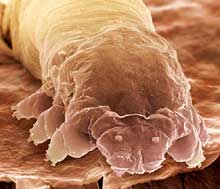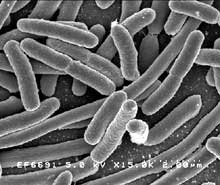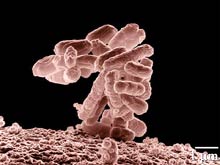|

June 27, 2008

Now that the month is almost over, I can say it: the June cover was . . . well . . . obscene. (Like Justice Potter Stewart, I know it when I see it.) Not to mention the opening shot of “Sex and the Single Schistosome.” Can you display this on your coffee table in the presence of children? Are parasites another one of the “facts of life” you’d just as soon postpone their finding out about?
Besides being scary and astonishing, Brian Sullivan’s scanning electron micrographs of male parasitic flatworms doing battle for females (oddly echoed two pages in by a pair of bellowing, decidedly macroscopic hippos) look like . . . I don’t know, like sex itself on a rampage, tiny privates duking it out. And then you read the article and learn that in a particularly bizarre twist, the beefy males possessively sequester females within their brawn, in a special channel called the gynecophoric [“woman-carrying”] canal, thereafter to live in “a perpetual state of copulation.” (This has even gotten the attention of one Ishtar Institute of Sexual Satisfaction. To me, it’s more redolent of certain grisly true-crime stories.) And when there aren’t any females around (like in prison?), you get “Well-developed males embracing small and sexually immature males.” (In their sexual dimorphism, schistosomes are unique among flatworms, most of which are hermaphroditic.)
If our gift and curse is to see some aspect of ourselves in every part of nature and nature in ourselves—the life cycle of leaves, the till-death-do-us-part of albatrosses, the harems of elephant seals, the wings of imagination—then what we are seeing here is naked id.
But parasites are a discomfiting fact of life in yet another way. They muddle our sense of boundaries, of individual integrity. (Come to think of it, sex does too.) We tend to think of ourselves as “in here,” on the safe side of the castle wall of our skin, and of potential threats and contaminants as “out there.” In reality, of course, each of us is like a planet swarming with other life-forms, outside and in. Most readers of this magazine won’t contract schistosomiasis (although, adventure and research travelers that many of us are, we may actually be at slightly higher risk for it than the average American). But we all have—this is my favorite—mites living in the roots of our eyelashes. Yep, they’re called Demodex folliculorum, and they live head-down in hair follicles, scarfing down sebaceous secretions and dead skin cells. (Yuck! But how yucky would we be without them?) The language in which scientists talk about them betrays a perhaps inadvertent but magical reduction of the observer to the scale of the observed:
The eyelid littoral offering protection and a moist environment is a significant site for egg laying.
“The eyelid littoral”! To them, it’s a beach!
Scanning electron microscopy really does reduce us in scale and take us on a Fantastic Voyage, turning us loose in a Lost World—Planet Us—where we encounter monsters as voracious and armor-plated as dinosaurs. Linking around, I happened on this cartoon parody of the miniaturized journey within, to do battle with “Parasites Lost”:
Fry: I got rid of the worms.
Leela: What? Why would you do that?
Fry: Leela, I had worms. I needed to know who you loved. Me or them.
Leela: Well... which of you wrote me that sonnet?
Actually, the episode’s comic premise—that parasites could modify a host’s behavior and personality, for better or worse—is not entirely far-fetched. A revelatory book on this very topic that we reviewed a year ago, Riddled With Life by Marlene Zuk, now out in paperback, is subtitled “Friendly Worms, Ladybug Sex, and the Parasites that Make Us Who We Are.”
Another few turns of the microscope screw, and we’re in the much more populous and various world of bacteria that colonize us, maintain or menace our health, and even make life possible.
[M]icrobes help us digest food and produce vitamins, protect us against infection, and are the main source of antibiotic medicines. The human cells in your body number 10 trillion, but that pales by comparison to the estimated 100 trillion microbial cells that live in and on you. “Without them, you would be in trouble,” [Harvard microbiologist Roberto]
Kolter says: animals experience abnormal growth and become sick if deprived of their microflora during development. Although a few microbes are known to cause disease, the precise role played by the vast majority is essentially unknown.
(Sneak preview: September promises an Olivia Judson “Life Zone” about mitochondria, the cellular energy factories—and possible aging culprits—that are almost certainly the descendants of bacteria that got into primitive cells either as home invaders or as lunch, and stayed.)
Humbling, on the one hand. But looked at another way, every one of us is entitled to the royal “we” (democratizing Mark Twain’s dictum, “Only kings, presidents, editors, and people with tapeworms have the right to use the editorial ‘we’”). And if each of us is an ecosystem, each of us is also an evolutionary palimpsest. Schistosomes are, in a sense, ancestors who’ve come home to roost. They belong to the phylum Platyhelminthes, or flatworms—the simplest animals to have three layers of cells instead of two (the new layer, “the mesoderm . . . produces muscular layers, an excretory system, and an elaborate reproductive system”), bilateral symmetry, and a head:
Cephalization, a specialization of the anterior end of the animal, can be seen in the clustering of sensory structures and clumps of nerves (ganglia or “brains”) in the head region.
Sound familiar? It’s a basic body plan we share—just as we share sexual dimorphism, sexual competition, and sexual possessiveness—with these tiny creatures one centimeter long. Unnerving evidence, that cover story, of common descent.
UPDATE: And just in time, this comes along:
From Victorian England to contemporary America, creationists have often denied that we are related to other primates. But the hard truth of our genealogy does even greater damage to human pride. We are cousins of every living thing, including the billions of E. coli bacteria in our intestines. This kinship may not be flattering, but it is useful.
That’s the opener of “E. Coli and You,” a review by Peter Dizikes of Microcosm: E. Coli and the New Science of Life, by Carl Zimmer.


(Annie Gottlieb) |
Comments (add yours!)

Return to June home
|




